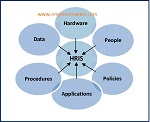
An information system for Human Resource Management (HRM) refers to the technology and software solutions used to manage and support HR processes within an organization. These systems are designed to automate and streamline HR activities, enhance data management, and improve overall efficiency and effectiveness. Here are some commonly used information systems for HRM:
- Human Resource Information System (HRIS): An HRIS is a comprehensive software solution that integrates various HR functions and processes into a centralized database. It typically includes modules for employee data management, recruitment, payroll, benefits administration, performance management, and reporting. HRIS systems provide a single source of truth for HR data and enable efficient data entry, retrieval, and analysis.
- Talent Management System (TMS): A TMS focuses on managing the entire talent lifecycle, from recruitment and onboarding to performance management and succession planning. It includes modules for applicant tracking, performance reviews, learning management, career development, and succession planning. TMS systems help organizations attract, develop, motivate, and retain top talent.
- Learning Management System (LMS): An LMS is used to deliver and manage training and development programs within an organization. It provides a platform for creating and delivering online courses, tracking learners’ progress, managing certifications, and assessing training effectiveness. LMS systems enable organizations to offer self-paced learning, blended learning, and compliance training.
- Time and Attendance Management System: This system automates time tracking and attendance management processes. It may include features such as time clock integration, scheduling, leave management, and absence tracking. It streamlines timekeeping, reduces manual errors, and facilitates accurate payroll processing.
- Compensation Management System: This system helps organizations manage their compensation programs and processes. It includes functionalities for salary planning, bonus allocation, variable pay management, and total rewards statements. Compensation management systems ensure fairness, consistency, and transparency in compensation practices.
- Employee Self-Service (ESS) and Manager Self-Service (MSS) Systems: ESS and MSS systems provide web-based portals or mobile applications that allow employees and managers to access and update HR-related information. Employees can view pay stubs, update personal information, request time off, and access HR policies and documents. Managers can review and approve leave requests, access employee performance records, and initiate HR processes.
- HR Analytics and Reporting Systems: These systems enable HR professionals to generate reports, analyze HR data, and gain insights into workforce trends, turnover rates, performance metrics, and other HR analytics. They provide visualizations, dashboards, and ad-hoc reporting capabilities to support data-driven decision-making.
While selecting an HRM information system, it’s important to consider factors such as the organization’s size, industry, budget, scalability, and integration capabilities with existing systems.
